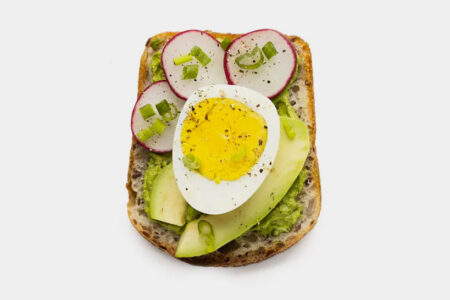OMAD Keto is a diet which combines keto diet and intermittent fasting with a 23:1 ratio.
What this means is that you would have one keto meal at your preferred time and fast for the rest of the day. You should aim to have all your daily macros and calories for the day in this one meal.
OMAD vs. Keto
OMAD: one meal a day
There are three types of OMAD diets:
- Caloric restriction and fasting: This is when someone decides to restrict their total calories for the day to a certain limit, eat all of those calories in one meal, and fast for the rest of the day.
- Non-caloric restriction and fasting: This is when someone decides to as many calories as they want in one meal and fast for the rest of the day.
- Non-caloric, eat whatever you want OMAD: This type is when someone chooses to eat anything they want (burgers, chips, etc.), as many calories as they want in one meal, and fast for the rest of the day.
OMAD keto
As stated in the beginning, OMAD Keto follows the same principle of eating one meal and fasting for the rest of the day. However, you will only have keto diet food.
OMAD Keto follows the general principle of the Ketogenic diet, which is to consume high fat, moderate protein, and low carb meals 1.
A significant difference between OMAD and OMAD Keto is that the latter means you’re already in ketosis. Thus it makes it easier for the body to use fat for fuel instead of carbs.
One of the main reasons why the keto diet works is because the high fat consumed in the diet not only helps induce ketosis, but it also enables you to feel fuller for longer than you would on a general OMAD diet.

Check our Keto Diet Plan For Beginners and download the PDF.
OMAD and Keto: Can You Do Both Together?
n of intermittent fasting, and thus, it works fine with the Ketogenic diet.
For those who don’t know what intermittent fasting is, it’s when you create a time pattern of when you can fast and when you can eat 2. For example, the 16:8 is a popular intermittent fasting protocol in the Keto community where you fast for 16 hours and have 8 hours to eat all your calories for the day.
OMAD Keto is the current advanced version of IF where you fast for 23 hours and eat for 1 hour.
If you decide to go for it, you still have to try your best to make sure you meet your daily macros in that one meal.
How to Start an OMAD Keto Diet
Step 1: Decide if it’s the one for you.
It’s easier to get inspired to participate in dieting when reading other people’s testimonies or YouTube videos.
However, OMAD Keto is not a one size fits all approach.
For example, if you’re suffering from a health condition that requires you to take medicine in the morning and night and requires you to eat before taking the meds, then OMAD might not be suitable for you.
Likewise, if you’ve never had any experience with fasting whatsoever, you might find it difficult to continue a diet that requires you to eat one big meal and fast for 23 hours.
Our best advice is to consult with your physician before making such significant changes to your diet.
Secondly, we recommend starting with other popular fasting keto diets such as the 16:8 or 20:4.
You can start with OMAD once you’ve gotten used to intermittent fasting on Keto diet.
Step 2: Remember your electrolytes.
If you’ve been practicing the keto diet for some time, you know that it’s diuretic, and can cause you to lose a lot of electrolytes in your urine which may cause symptoms of keto flu such as fatigue, vomiting, dizziness, and more.

You can avoid keto flu by doing the following:
- Sip sea salt or Himalayan salt water throughout the day.
- Eat pickles and add a generous amount of salt to your salads.
- Take magnesium in supplement form.
- Avocado fulfills a significant proportion of your daily fat and potassium requirement.
Step 3: Start slow.
As mentioned in step 1, if you’re entirely new to intermittent fasting, we recommend you start slow with the 16:8 fasting protocol once or twice a week.
This would give your body enough time to get adapted to the fasting routine and thus reduces the chance of any adverse effects you may experience if you suddenly jump on the OMAD Keto diet.
Starting slow will also give you the chance to see how well your body would tolerate if and when you switch to OMAD.
Step 4: Preparing your meal.
As with any diet, you’d want to make sure you have your weekly groceries, and keto food staples stocked in advance.
Some staples you’d want to stock in advance include olive oil, your choices of meat, eggs, mozzarella and cheddar cheese, butter, almond flour, coconut flour, cream cheese, avocados, spinach, and nuts.
Meat can usually be stored in the freezer for up to several months.
Plan your meal for the next day. Think about what meat, veggies, and dairy items you’ll need to have to meet your daily macros so you can plan your meal around that.
You don’t have to make a different variety of dishes if you don’t want to. Just make a large meal of one dish instead. For example, you can make one big keto taco with extra salad on the side.
Since OMAD has a long fasting window, you’ll likely be starving by the time you want to eat your meal. Hence, make your meal in the early morning and refrigerate it if you have to work from morning till late evening.
Alternatively, you can also prepare your meal at least two hours before it’s time to eat.
Step 5: Stay low on cheese and cream.
Keep your cheese and cream to a moderate level because they can fill you up quickly and make you not want to eat the rest of your meal.
Step 6: Make a meal plan.
A weekly meal plan is one of the best ways to keep yourself organized on any diet. Create a simple weekly meal plan for each week, so you don’t have to waste time thinking about what to eat next.
Having a meal plan would also help to ensure that all your macros are in each meal.
Step 7: Eat slowly.
Eating slowly might be the last thing on your mind when you’ve been fasting all day but try your best to do it.
Chewing your food slowly will give more time for the saliva enzymes to penetrate the food particles and speed up digestion 3.
Step 8: Stay hydrated.
Make sure to drink plenty of water throughout the day to avoid the consequences of dehydration such as fatigue and headache.
Step 9: OMAD and exercise
The morning hours (6-11am) are considered the best in the keto community if you wish to do exercise on OMAD Keto diet.
Advantages of OMAD Keto
Here are some of the main benefits of doing an OMAD Keto diet:
Flexibility
There are no fixed times to eat during an OMAD diet. Keeping the 23:1 ratio in mind, you can decide the hour you want to eat your meal for the day.
This is a huge advantage for busy working individuals who find it harder to stay committed to the Keto diet. You can come home and have your meal for the day at night and still reap the benefits of OMAD Keto.
It’s also a big advantage for frequent travelers who often find it challenging to eat keto meals on the go. You don’t have to stress about three meals or even two, eat your big meal for the day in the morning or evening and you’re good to go.
Less work
Since you’ll be having all your meals for the day in one go, you’ll save time from cooking three different meals for each day. What this means is that you can make a large portion of whatever it is you want to eat to meet your calories for the day.
You also don’t have to invest time on meal prepping three meals for the day for each week.
Freedom
For those who miss their carbs, OMAD Keto will allow you to eat all your 50 grams or fewer carbs per day in one go, so you get to have a meal that makes you feel completely satiated.
Buffet weight loss
Since you’ll be trying to have all your daily macros for the day in one meal, you’re less likely to go overboard and eat more calories than you should.
OMAD is quite similar to eating at a buffet restaurant, you know you can eat as much as you want and you do, however, you’ll end up feeling fuller at some point and simply can’t eat anymore.
Fasting benefits
OMAD Keto allows the body to have more time to reap the health benefits of fasting.
Disadvantages of OMAD Keto
Not suitable for everyone
As mentioned earlier, OMAD is not for everyone. Some people might have health conditions that require them to eat three meals a day, and it might also not be suitable for pregnant or breastfeeding women.
Likewise, it might not be the best option for those who’ve never tried intermittent fasting before. It’s best to get used to other minor types of intermittent fasting on the Keto diet before starting the One Meal A Day diet.
You’ll have to consult with your doctor before if you fall in those categories.
Risk of undereating
Some people might feel fuller faster during an OMAD Keto diet and thus not meet their daily recommended calories. It’s not a big deal to miss out on a few calories on some days but eating prolonged periods of fewer calories per day can lead to losing too much weight.
Takeaway
- OMAD (One Meal A Day) can work perfectly fine with Keto. As discussed earlier, it gives you the flexibility and freedom to eat all your meals for the day in one go.
- You don’t have to worry about cooking three meals or meal prepping for each one if you’re a busy individual. You can come home from work and consume a large Keto meal for dinner or at any hour that is suitable for you. That said, you still have to try your best to meet your daily macros in that meal.
- However, it’s best to discuss OMAD Keto with your physician first if you happen to suffer from any significant health conditions, and if you’re pregnant or breastfeeding. If you’re a complete newbie to fasting, we strongly recommend that you start with other easier types of intermittent fasting first before trying OMAD.
- It’s fine to exercise on OMAD Keto, in fact, it’s considered to boost weight loss results in many people in the keto community. The best recommended time to exercise in this diet is the morning hours between 6-11am.










![Juicing for Weight Loss: Everything You Need to Know [Plus Recipes]](/wp-content/uploads/2019/08/Juicing-for-Weight-featured-image.jpg)










